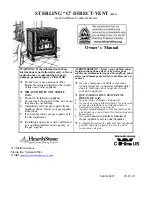
Gas Input Rate
GKNE-SVX001B-EN
31
record adjusted manifold pressure, altitude of the unit
installation and the technician’s name and date on the
label using a permanent marker.
Refer to Installation Instruction section on Adjustments-
Gas Input Rate for adjusting the manifold pressure.
Table 10. High altitude deration - United States
Altitude
Manifold Pressure
BTU Output
1
Natural Gas
2
Liquid Propane
3
Feet
Meters
Inches
W.C.
Pa
Inches
W.C.
Pa
Percent
0-2,000
0-610
3.5
872
10
2,491
100%
2,001-3,000
611-915
3.2
797
9.2
2,292
96%
3,001-4,000
916-1,220
2.9
722
8.4
2,092
92%
4,001-5,000
1,221-1,525
2.7
673
7.7
1,918
88%
5,001-6,000
1,526-1,830
2.4
598
7
1,744
84%
6,001-7,000
1,831-2,135
2.2
548
6.4
1,594
80%
7,001-8,000
2,136-2,440
2
498
5.7
1,420
76%
8,001-9,000
2,441-2,745
1.8
448
5.1
1,270
72%
9,001-10,000
2,746-3,045
1.6
399
4.6
1,145
68%
Notes:
1. Deration based on ANSI Z223.1 (NFPA 54).
2. Table based on heating value of 1,050 BTU/Cu. ft. at sea level.
3. Table based on heating value of 2,500 BTU/Cu. ft. at sea level.
4. Consult local utility for actual heating value.
Table 11. High altitude deration - Canada
Altitude
Manifold Pressure
BTU Output
1
Natural Gas
2
Liquid Propane
3
Feet
Meters
Inches
W.C.
Pa
Inches
W.C.
Pa
Percent
0-2,000
0-610
3.5
872
10
2,491
100%
2,001-3,000
611-915
3.2
797
9.2
2,292
96%
3,001-4,000
916-1,220
2.9
722
8.4
2,092
92%
4,001-4,500
1,221-1,371
2.8
697
7.9
1,968
90%
Notes:
1. Deration based on CGA 2.17-M91
2. Table based on heating value of 1,050 BTU/Cu. ft. at sea level.
3. Table based on heating value of 2,500 BTU/Cu. ft. at sea level.
4. Consult local utility for actual heating value.
Table 12. Separated combustion tubular blower troubleshooting guide
SYMPTOMS
POSSIBLE CAUSE(S)
CORRECTIVE ACTION
A. Flame pops back.
1. Burner orifice too small.
1. Check with local gas supplier for proper orifice
size and replace. Refer to "Gas Input Rate."
B. Noisy Flame.
1. Irregular orifice causing whistle or
resonance.
2. Excessive gas input.
1. Replace orifice.
2. Test and reset manifold pressure (see Table 4 -
"Gas Piping Requirements").
C. Yellow tip flame (some yellow tipping on LP
gas is permissible).
1 Clogged main burners.
2. Misaligned orifices.
3. Insufficient combustion air.
4. Possibly over fired.
1. Clean main burner ports.
2. Replace manifold assembly.
3. Refer to "Installation - Clearances" and
"Venting" to ensure unit is properly mounted
and vented.
4. Check gas input and manifold pressures.














































